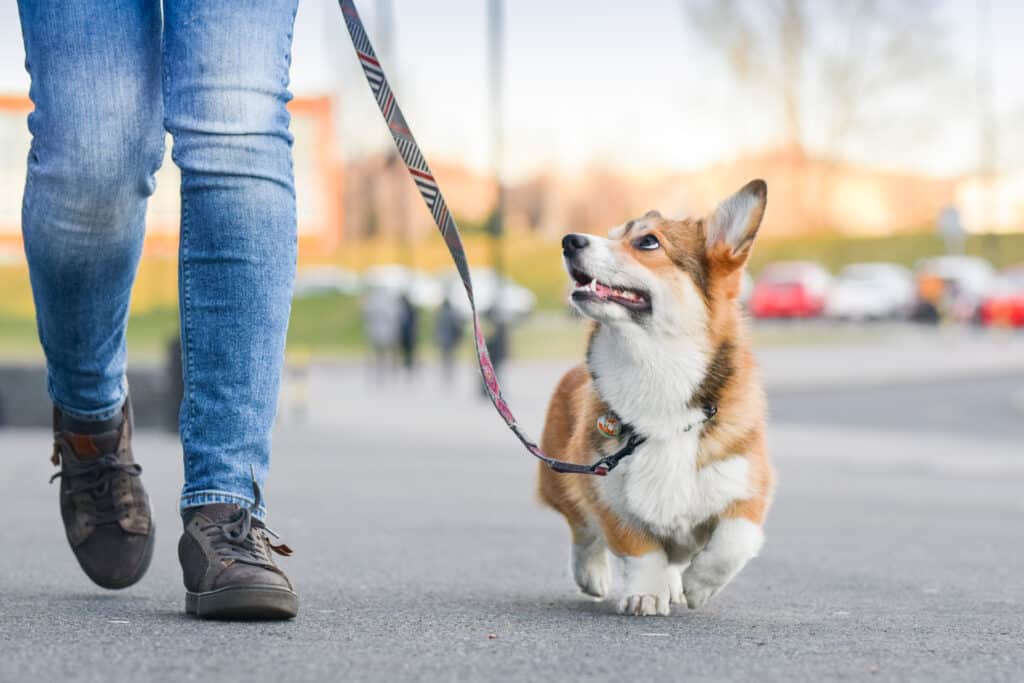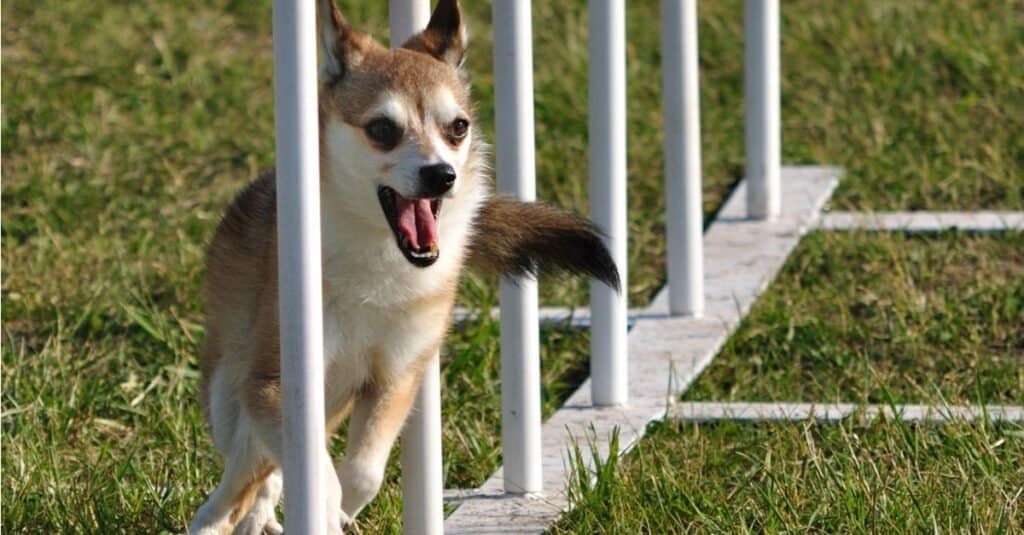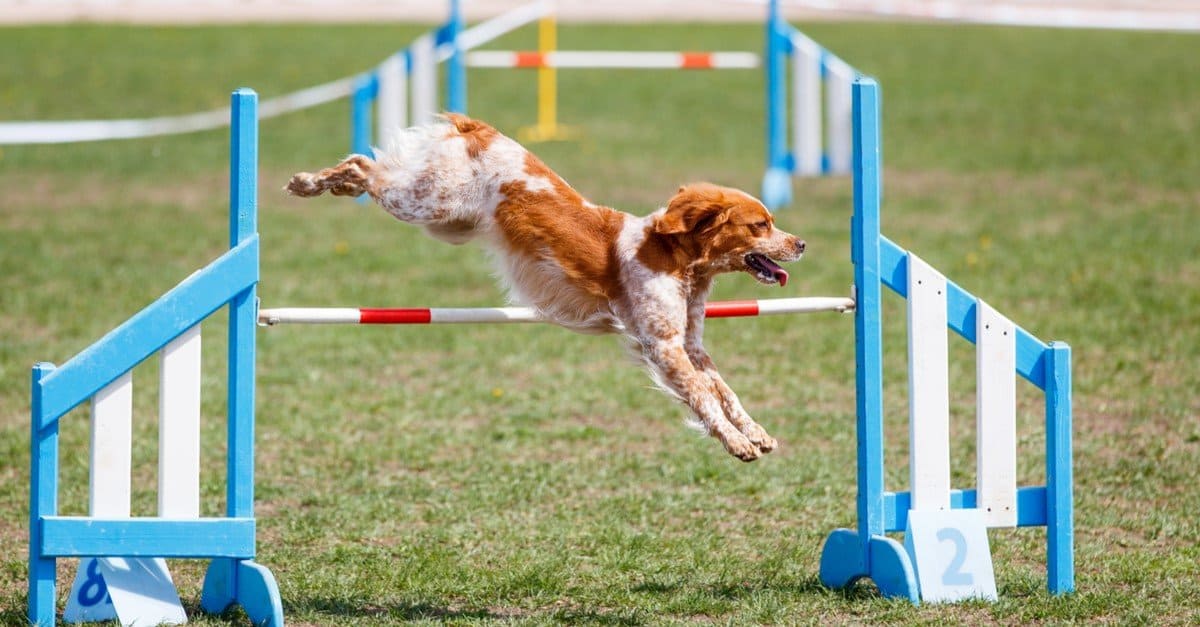Key Tips
- You can get started with dog agility with treats and toys.
- Your dog can be any size or shape — but must be healthy and have a solid handle on basic obedience.
- Group lessons balance affordability and give you a social outlet!
The first dog agility demonstration occurred in 1978 at the Crufts Dog Show in England. The point was to create something interesting involving dogs that would fill the time between dog show components.
By 1986, the United States Dog Agility Association formed and created the first stateside sanctioning organization for the growing sport.
Today several organizations regulate and sanction competitions, called trials — each with their own rules, jump heights, and judging. No one foresaw the new sport’s growth, but agility’s popularity has only grown since then!
Which Dog Breeds Are Best for Agility?
The answer to the question of which dog breeds are best depends on your goals. While certain dog breeds are better suited to the demands of high-level competition in dog agility, this game is for everyone!
When watching agility trials online, you will see many Australian shepherds and border collies in the higher jump classes. However, everything from tiny little Chihuahuas to huge Irish wolfhounds love the game — many breeds and mixed breeds compete in sanctioned agility trials worldwide.
If your goal is to have fun, grow your relationship with your dog, and maybe compete in a trial — any healthy dog that likes to run, jump, and play with you can be successful.
1. Get a Veterinary Checkup Before You Start Agility Training

Having a veterinary checkup for your dog before you get started in agility can prevent injuries.
©megaflopp/iStock via Getty Images
Let the vet know you plan to get your pup started in dog agility training. Ask them for a complete physical.
Dogs are Class-A stinkers when it comes to letting us know when they hurt. Seriously — some of our four-legged friends could have a snakebite, a raccoon hanging off their tail, and be missing an ear and still want to play ball. So, before you start any exercise or training regimen, make sure your pooch is physically ready for it.
2. Get Basic Obedience Skills

Basic obedience like walking nicely on a leash helps make agility training easier.
©Jus_Ol/Shutterstock.com
Before you get started teaching your dog how to navigate any agility obstacles, they need a few basic obedience skills. They do not need any advanced obedience titles. However, those are always nice! As you work with your dog, you will discover several truths:
- Your dog will always do their best — yelling and getting frustrated are counterproductive.
- You will get out of the relationship exactly as much as you put in.
- It is usually our fault they messed up.
- Dogs are usually smarter than we think.
Ready? Let’s get started!
Recall
This might be obvious. But if your dog doesn’t come when you call them, getting around an agility course is nearly impossible. Most of your agility training and all agility competitions are off-leash.
Sit or Down
Eventually, you will need a great sit and a fantastic down. However, in the beginning, one or the other is just fine! Consistent work is key.
Stay
Handy for all sorts of purposes, a stay cue or command is vital. A dog needs to stay put at the course’s start line so you can get in position! Broken start lines cause all sorts of havoc for agility competitors. Besides, who wouldn’t love a dog who stayed put when they were told?
Target or Touch
Contact obstacles have zones that your dog must touch their paws to as they navigate it. Teaching a simple target or touch cue using a plastic container lid gives you a first step toward getting contact obstacles right.
Additional Helpful Skills
Every additional skill or trick you teach your pup will increase their ability to focus and learn new skills. After all, the more they learn, the more they are capable of learning!
Look/Focus. Pups need to know where to look. In the beginning, that’s often you — their handler. A look or focus cue will help.
Leave it. A solid “leave it!” can prevent a lot of problems before they become problems. Bird poo on the ground? Leave it! The last dog peed on the jump? Leave it!
Ignoring distractions. Learning how to focus under pressure and with distractions makes a more positive agility experience.
This frustrating moment is a common sight among newer agility dogs — my own dog has done something similar!
Imagine you are at a trial.
The course is great, your dog is fast, your timing is spot on…and your dog sees another dog. Or your significant other. Or…insert distraction.
Depending on the competition’s level and venue, you may still be able to get a qualifying score (known as a Q) if you get your dog back on track quickly enough. However, sometimes it is game over — no Q for you!
Part of your dog’s agility training is learning to ignore distractions. This skill is valuable in daily life too! No one wants to damage their arm because Fido decided to go after the neighbor’s cat. The only way they learn is with practice. Unfortunately, you don’t always know exactly where their training is until the stimulus appears.
Being well-socialized. What do you imagine when someone says you must socialize your dog? If you’re like most people, you likely consider how well they interact with other dogs. However, that isn’t what dog trainers think of as socializing a dog.
Here is how it looks:
- A well-socialized dog can walk down the street peacefully — they typically won’t pull, bark, or lunge at people and other pets.
- They can politely meet new people.
- They do not feel the need to visit every single dog they see.
If your dog pulls on the leash, lunges, barks, or jumps when they come too close to someone or another dog, they need more practice. Remember that your dog does not need to heel perfectly, all the time. A little ahead of you or behind is no big deal. The main thing is they do not react out of fear or over-exuberance.
3. Get Basic Equipment for Training

Tug and fetch toys can be really helpful in dog agility.
©Ryan Brix/Shutterstock.com
At first, your focus is on learning to work with your dog. So, the only equipment you need to practice at home is a treat pouch, small treats about the size of your pinkie nail, a favorite toy, and a training clicker if you use one.
A few extra items may be useful:
- Mat or towel for your dog to lay down on. It’s part of an exercise to maintain calm wherever they happen to be and becomes a way for them to calm themselves.
- Plastic lid from a container. These nearly flat lids make perfect touch targets for training!
- Water bowl. Training is hard work! They’ll need a drink sometimes.
- PVC jumps that you can set to a low height — if your dog is still a pup, keep the jumps super low.
- A play tunnel that’s big enough for your dog to go through.
A note on clickers — I have used clickers and own several. In principle, they are fantastic. However, some find that the extra “thing” in their hands proves too much of a distraction for the human. A quick and happy “yes!!” is just as effective.
4. Decide on Training Classes — Online or In-Person?

Training classes can be online or in-person, but you will always need to practice outside of class!
©Paya Mona/Shutterstock.com
Agility classes are widely available. You may be able to find group or private lessons within a club setting or at an instructor’s facility within a short drive of your home. However, some regions with extreme winter or summer weather shut down until the weather improves.
Most clubs and instructors require that you and your dog complete a basic obedience class before you can get started in dog agility classes. Some allow you in without the obedience class if you can prove your dog has the necessary skills. Don’t take this personally. They need to know that you and your dog can handle the training and practice required. However, they also need to know your dog is well-behaved and isn’t a danger to other dogs or people.
I am the first to say that in-person lessons are always preferable to online. Always. That live instructor can pick apart what you did wrong or right, so you can improve. Also, they usually have access to bigger, more expensive equipment like a-frames, dog walks, and teeters that can be dangerous if not trained correctly.
However, if your training facility must shut down during the hot summer months or is buried in snow, online courses can help you keep moving forward.
Another advantage of taking online courses when you cannot be there in person is you get to see a different perspective on training and working with your dog. Yet, that can also work against you in the beginning. Getting too much information from too many sources when you are only beginning to figure things out can confuse you. It is often best to stick with one style until you know what works for your pooch.
Be selective if you need to bounce between online and in-person lessons for any reason. Talk with your instructor if you have questions. They may be able to set up video lessons when they have to close the facility for a few weeks in the summer.
5. Find Out Which Agility Organizations are Active in Your Region

Weave poles are one of the most difficult obstacles for dogs to learn and shouldn’t be taught until their growth plates are closed.
©Mark Herreid/Shutterstock.com
Before you compete in your first agility trial, attend a few! If your dog is ready for the distractions inherent to a live trial and the trial allows non-competing dogs, take them. The experience they will gain just by being around the trial environment will be valuable and give you clues on how they will handle it when the time comes.
Take some time to find out which dog agility organizations have active clubs and other host groups. Here are the most common in the U.S.
- North American Dog Agility Council (NADAC)
- United States Dog Agility Association (USDAA)
- American Kennel Club (AKC)
- Canine Performance Events (CPC)
Although it takes a lot of time and training to get started in dog agility, this sport is full of terrific people who cheer each other on. At trials, we compete against one another – the first, second, and third-place qualifying times get an extra ribbon and bragging rights. However, most agility competitors are there because they love training and playing with their dogs – the competition is between them and their goals, not the other dogs.
Ready to discover the top 10 cutest dog breeds in the entire world?
How about the fastest dogs, the largest dogs and those that are -- quite frankly -- just the kindest dogs on the planet? Each day, AZ Animals sends out lists just like this to our thousands of email subscribers. And the best part? It's FREE. Join today by entering your email below.
Thank you for reading! Have some feedback for us? Contact the AZ Animals editorial team.








